Ahsan Manjil, the pink palace, has a 2 taka entrance fee and a small exhibition about the history of the palace and a garden. Star Mosque (Sitara Mosque) is a small mosque dating back three hundred years, inlaid with mosaic and tiles. Shisu Mela is the children playground in Shyamoli.
the pink palace, has a 2 taka entrance fee and a small exhibition about the history of the palace and a garden. Star Mosque (Sitara Mosque) is a small mosque dating back three hundred years, inlaid with mosaic and tiles. Shisu Mela is the children playground in Shyamoli.
For The Religious People
Mosques around Dhaka: Dhak a has several hundred mosques. Prominent are Baitull Mukarram-National Mosque, the seven Domed Mosque (17th century), Star Mosque (18th century) , Chawkbazar Mosque and Huseni Dalan Mosque.
a has several hundred mosques. Prominent are Baitull Mukarram-National Mosque, the seven Domed Mosque (17th century), Star Mosque (18th century) , Chawkbazar Mosque and Huseni Dalan Mosque.
Hindu Temples: Dhakeshwari Temple (11th Century), Ramkrishna Mission.
Dhakeshwari Temple (11th Century), Ramkrishna Mission.
Churches: Armenian Church (1781 A.D.) St. Mary's Cathedral at Ramna, Church of Bangladesh or former Holy Rosary Church (1677A.D.) at Tejgaon.
Buddhist Temples:
Dhammarajika Bouddha Maha Vihar , Atisa Dipankar Sarak, Kamalapur.
International Buddhist Monastery, Merul Badda, Gulshan.
For Those Who have Interest In Arts, History and Culture
The National Memorial: It locates at Savar, 35, km. from Dhaka city. The memorial designed by architect Moinul Hossain is dedicated to the sacred memory of the millions of unknown martyrs of the war of liberation.
It locates at Savar, 35, km. from Dhaka city. The memorial designed by architect Moinul Hossain is dedicated to the sacred memory of the millions of unknown martyrs of the war of liberation.
Lalbagh Fort: It was built in 1678 A.D. by Prince Mohammad Azam, son of Mughal emperor Aurangazeb. The fort was the scene of bloody battle during the first war of independence (1857) when 260 sepoys stationed here backed by the people revolted against British forces. Outstanding among the monuments of the Lalbagh are the tomb of Pari Bibi , Lalbagh Mosque, Audience Hall and Hammam of Nawab Shaista Khan now housing a museum.
The capital city Dhaka predominantly was a city of the Mughals. In hundred years of their vigorous rule successive Governors and princely Viceroys who ruled the province, adorned it with many noble monuments in the shape of magnificent places, mosques, tombs, fortifications and 'Katras' often surrounded with beautifully laid out gardens and pavilions. Among these, few have survived the ravages of time, aggressive tropical climate of the land and vandal hands of man.
But the finest specimen of this period is the Aurangabad Fort, commonly known as Lalbagh Fort, which, indeed represents the unfulfilled dream of a Mughal Prince. It occupies the south western part of the old city, overlooking the Buriganga on whose northern bank it stands as a silent sentinel of the old city. Rectangular in plan, it encloses an area of 1082' by 800' and in addition to its graceful lofty gateways on south-east and north-east corners and a subsidiary small unpretentious gateway on north, it also contians within its fortified perimeter a number of splendid monuments, surrounded by attractive garden. These are, a small 3-domed mosque, the mausoleum of Bibi Pari the reputed daughter of Nawab Shaista Khan and the Hammam and Audience Hall of the Governor. The main purpose of this fort, was to provide a defensive enclosure of the palacial edifices of the interior and as such was a type of palace-fortress rather than a seige fort.
1857 Memorial: ( Bahadur Shah Park) Built to commemorate the martyrs of the first liberation war (1857-59) against British rule. It was here that the revolting sepoys and their civil compatriots were publicly hanged.
Bahadur Shah Park) Built to commemorate the martyrs of the first liberation war (1857-59) against British rule. It was here that the revolting sepoys and their civil compatriots were publicly hanged.
Bangabandhu Memorial Museum: The residence of the father of the nation Bangabandhu Sheikh Mujibur Rahman at Dhanmondi has been turned into a musuam. It contains rare collection of personal effects and photographs of his lifetime.
Liberation War Museum: Situated at Segun Bagicha area of the city the museum contains rare photographs of Liberation war and items used by the freedom fighters during the period.
Ahsan Manzil Museum: On the bank of the river Buriganga in Dhaka the pink majestic Ahsan Manzil has been renovated and turned into a museum recently. It is an example of the nations rich cultural heritage. It was the home of the Nawab of Dhaka and a silent spectator to many events. The renovated Ahsan Manzil is a monument of immense historical beauty. It has 31 rooms with a huge dome atop which can be seen from miles around. It now has 23 galleries displaying portraits, furniture and household articles and utensils used by the Nawab.
Curzon Hall:  Beautiful architectural building named after Lord Curzon. It now houses the Science Faculty of Dhaka University.
Beautiful architectural building named after Lord Curzon. It now houses the Science Faculty of Dhaka University.
Old High Court Building: Originally built as the residence of the British Governor, it illustrates a happy blend of European and Mughal architecture.
Dhaka Zoo: Popularly known as Mirpur Zoo. Colorful and attractive collections of different local and foreign species of animals and birds including the majestic Royal Bengal Tiger are available here.
National Museum: Located at the central point of the city, the museum contains a large number of interesting collections including sculptures and paintings of the Hindu, Buddhist and Muslim periods.
Botanical Garden:  Built on an area of 205 acres of land at Mirpur and adjacent to Dhaka Zoo. One can have a look at the zoo and the botanical garden in one trip.
Built on an area of 205 acres of land at Mirpur and adjacent to Dhaka Zoo. One can have a look at the zoo and the botanical garden in one trip.
National Park: Situated at Rejendrapur, 40 km. north of Dhaka city , this is a vast (1,600 acres) national recreational forest with facilities for picnic and rowing etc.
Central Shahid Minar: Symbol of Bengali nationalism. This monument was built to commemorate the martyrs of the historic Language movement of 1952. Hundreds and thousands of people with floral wreaths and bouquet gather on 21 February every year to pay respect in a solemn atmosphere. Celebrations begin at zero hour of midnight.
Symbol of Bengali nationalism. This monument was built to commemorate the martyrs of the historic Language movement of 1952. Hundreds and thousands of people with floral wreaths and bouquet gather on 21 February every year to pay respect in a solemn atmosphere. Celebrations begin at zero hour of midnight.
National Poet's Graveyard: Revolutionary poet Kazi Nazrul Islam died on the 29 August 1976 and was buried here. The  graveyard is adjacent to the Dhaka University Mosque.
graveyard is adjacent to the Dhaka University Mosque.
Suhrawardy Uddyan (Garden): A Popular Park. The oath of independence of Bangladesh was taken here and Father of the Nation Bangabandhu Sheik Mujibur Rahman gave clarion call for independence on this occasion on the 7th March 1971. The place is famous for its lush verdure and gentle breezes. Eternal Flame to enliven the memory of the martyrs of our Liberation war has been blown here recently.
Mausoleum of National Leaders: Located at the southwestern corner of Suhrawardy Uddyan, it is the eternal resting place of great national leaders, Sher-e-Bangla A.K. Fazlul Haque, Hossain Shahid Suhrawardy and Khaja Nazimuddin.
Banga Bhaban: T he official residence of the President, located in the city. One can have an outside view of this grand palace.
he official residence of the President, located in the city. One can have an outside view of this grand palace.
Baldha Garden : Unique creation of the late Narendra Narayan Roy, the landlord of Baldha. Year of establishment was 1904. Located in Wari area of Dhaka city, the garden with its rich collection of indigenous and exotic plants is one of the most exciting attraction for naturalists and tourists.
: Unique creation of the late Narendra Narayan Roy, the landlord of Baldha. Year of establishment was 1904. Located in Wari area of Dhaka city, the garden with its rich collection of indigenous and exotic plants is one of the most exciting attraction for naturalists and tourists.
Ramna Green:  A vast stretch of green garden surrounded by a serpentine lake near the Sheraton Hotel.
A vast stretch of green garden surrounded by a serpentine lake near the Sheraton Hotel.
Parliament House: Jatiya Sangsad Bhaban (Parliament House) located at Sher-e-Bangla Nagar has distinctive architectural features. Designed by the famous architect Louis I. Kahn, it may be called an architectural wonder of this region.
Science Museum:  The museum is a modern learning center related to the latest scientific discoveries. It is situated at Agargaon.
The museum is a modern learning center related to the latest scientific discoveries. It is situated at Agargaon.
Institute of Arts and Crafts: Situated in the picturesque surroundings of Shahbagh the Institute of Arts and Crafts has a representative collection of folk-art and paintings by artists of Bangladesh.
Sonargaon: About 29 km. from Dhaka. Sonargaon is one of the oldest capitals of Bangal. A Folk Arts and Crafts Museum has been established here.
Other attractions in and around Dhaka include the Institute of Arts and Crafts with its representative collection of folk art and paintings, handicraft shops. Aparajeya Bangla monument, picnic spots at Chandra and Salna, industrial estates of Tongi, Narayanganj, Demara, Tejgaon, cruising by country boat in the nearby river or a visit to a village to see jute cultivation, weaving and pottery making. Last but not the least travel by a horse driven cart or rickshaw along busy Dhaka streets is a rewarding experience.
About 27 km. from Dhaka, Sonargaon is one of the oldest capitals of Bengal. It was the seat of Deva Dynasty until the 13th century. From then onward till the advent of the Mughals, Sonargaon was subsidiary capital of the Sultanate of Bengal. Among the ancient monuments still intact are the Tomb of Sultan Ghiasuddin (1399-1409 A. D), the shrines of Panjpirs and Shah Abdul Alia and a beautiful mosque in Goaldi villaae.
Other Activities
Picnic Spots: There are good picnic spots in the area around Savar and Mirzapur. Other beauty spots connected by road with Dhaka include Joydevpur, Sripur, Madhupur, Rajendrapur National Park, Chandra and Salna, all of which have rest-houses that can be used by tourists on request to the Forest Department.
Bangaldesh Parjatan Corporation owns two picnic spots with Bunglows at Chandra and Salna which can also be hired by tourists.
Mosque of Baba Adam: Of a slightly later date the elegant 6-domed mosque (43'x36') of Baba Adam in Rampal near Dhaka was erected by one Malik Kafur during the reign of the last llyas Shahi Sultan, Jalauddin Fateh Shah in 1483 A.D. It displays the same characterstic features of the period such as the faceted octagonal turrets at 4 corners, the curved cornice, the facade and 3 mihrabs relieved richly with beautiful terracotta floral and hanging patterns.
Star Mosque: A very beautiful mosque of the city is situated at Mahuttuly on Abul Khairat Rd; just west of Armanitola Govt. High School. Architecturally faultless (Mughal style) is a five-dome mosque with hundreds of big and small twinkling stars as surface decorations. The stars have been created by setting pieces of chinaware on white cement. Seen from the front and from far it looks as if shining above the surface of the earth. The inside of it is even more beautiful that the outside, lovely mosaic floor and excellent tiles with many floral patterns set on the walls, are all in complete harmony. The sitara Masjid was built originally with three domes in early 18th century by Mirza Ghulam Pir, a highly respectable Zamindar of Dhaka. Frequently used in calendars. Entrance: through a lane named after the mosque
Foy's Lake
|
War Cemetery
|
D.C. Hill
|
The Batali Hill
|
Zia Museum
|
Patenga Sea Beach
|
Sundarbans
Located at about 320km. West of Dhaka. Here in the south, spread over an area of about 6000 sq. km. of delta swamps along the coastal belt of Khulna is the biggest mangrove forest, Sundarbans (beautiful forest) - the home of the Royal Bengal Tiger. These dense mangrove forests are criss-crossed by a network of rivers and creeks. One find here tides flowing in two directions in the same creek and often tigers swimming across a river or huge crocodiles basking in the sun. Other wildlife in this region is cheetahs, spotted deer, monkeys, pythons, wild bears and hyenas.
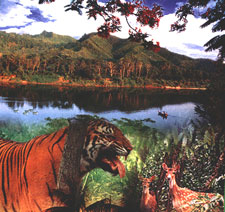
The forest is accessible by river from Khulna and Mongla. There are rest houses for the visitors to stay and enjoy the unspoiled nature with all its charm and majesty. Spending some times inside the forest can be a rare treat for the lovers of nature. BPC offers package tours to Sundarbans.
Kaptai
Kaptai is an upazila under Rangamati district. It is famous for hydro-electric project. A panoramic man-made lake called Kaptai lake (680-sq. km.) in the midst of hills has added to its beauty. A pleasant and picturesque drive of 64 km. from Chittagong brings you to huge expanse of emerald and blue water ringed with tropical forest. Only 3 km. from Kaptai along Chittagong road, lies the ancient Chit Morong Buddhist temple having beautiful Buddhist statues.
Kuakata
A rare scenic beauty spot on the southern most tip of Bangladesh in the district of Patuakhali. It has a wide sandy beach from where one can get the unique opportunity of seeing both the sunrise and sunsetting. It is located at a distance of 70 km. from the district headquarters of Patuakhali. Accessible by road, by air to Barisal and then by road, by river vessel.
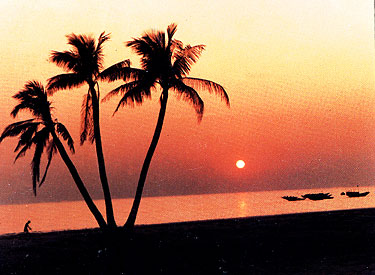
Kuakata, locally known as Sagar Kannya (Daughter of the Sea) is a rare scenic beauty spot on the southernmost tip of Bangladesh. Kuakata in Latachapli union under Kalapara Police Station of Patuakhali district is about 30 km in length and 6 km in breadth. It is 70 km from Patuakhali district headquarters and 320 km from Dhaka. At Kuakata excellent combination of the picturesque natural beauty, sandy beach, blue sky, huge expanse of water of the Bay and evergreen forest in really eye-catching.
Kuakata is one of the rarest places which has the unique beauty of offering the full view of the rising and setting of crimson sun in the water of the Bay of Bengal in a calm environment. That perhaps makes kuakata one of the world's unique beaches. The long and wide beach at Kuakata has a typical natural setting. This sandy beach has gentle slopes into the Bay of Bengal and bathing there is as pleasant as is walking or diving. Kuakata is truly a virgin beach-a sanctuary for migratory winter birds, a series of coconut trees, sandy beach of blue Bay, a feast for the eye. Forest, boats plying in the Bay of Bengal with colourful sails, fishing, towering cliffs, surfing waves everything here touches every visitor's heart. The unique customs and costumes of the 'Rakhyne' tribal families and Buddhist Temple of about hundred years old indicate the ancient tradition and cultural heritage, which are objects of great pleasure Kuakata is the place of pilgrimage of the Hindus and Buddhist communities. Innumerable devotees arrive here at the festival of 'Rush Purnima' and 'Maghi Purnima'. On these two days they take holy bath and traditional fairs are held here. All these additional offers to panoramic beauty make the beach more attractive to the visitors. One should visit Kuakata and discover the lovely grace of Bangladesh.
Tamabil & Jaflong
Situated amidst splendid panorama, Tamabil is a border outpost on Sylhet-Shilong road, about 55 km. away from Sylhet town. Beside enchanting views of the area one can also have a glimpse of the waterfall across the border from Tamabil. Jaflong is also a scenic spot nearby amidst tea gardens and rare beauty of rolling stones from hills.
Mainamati
An isolated low, dimpled range of hills, dotted -with more than 50 ancient Buddhist settlements of the 8th to 12th century A.D. known as Mainamati-Laimai range are extended through the centre of the district of Comilla.
Salban Vihara, almost in the middle of the Mainamati-Lalmai hill range consists of 115 cells, built around a spacious courtyard with cruciform temple in the centre facing its only gateway complex to the north resembling that of the Paharpur Monastery.
Kotila Mura situated on a flaftened hillock, about 5 km north of Salban Vihara inside the Comilla Cantonment are is picturesque Buddhist establishment. Here three stupas are found side by side representing the Buddhist "Trinity" or three jewels i.e. the Buddha, Dharma and Sangha.
Charpatra Mura is an isolated small oblong shrinesituated about 2.5 krn. north-west of kotila Mura stupas. The only approach to the shrine is from the East through agateway which leads to a spacious hall.
The Mainamati site Museum has a rich and varied collection of copper plates, gold and silver coins and 86 bronze objects. Over 150 bronze statues havo been recovered mostly from the monastic cells, bronze stupas, stone sculptures and hundreds of terracotta plaques each measuring on an average of 9" higli and 8" to 12" wide. Mairiamati is only 114 km. from Dhaka City and is just a day's trip by road on way to Chittagong.
Cox's Bazar
Located at a distance of 152 km. to the south of Chittagong, Cox's Bazar is the tourist capital of Bangladesh. Having the world's longest unbroken (120 km.) beach sloping gently down to the blue waters of the Bay of Bengal against the picturesque background of a chain of hill covered with deep green forests, Cox's Bazar is one of the most attractive tourist spots in the world. Miles of golden sands, towering cliffs surfing waves, rare conch shells, colorful pagodas, Buddhist temples and tribes, delightful seafood - these are specialties of Cox's Bazar.
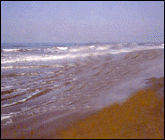
The beach is good for bathing, sunbathing and swimming. The breath-taking beauty of the sun-setting behind the waves of the sea is captivating. Attractive local variety of cigars and handloom products of the Rakhyne tribal families are good buys. Their unique customs and costumes attract visitors.
Cox's Bazar is connected both by air and road from Dhaka and Chittagong.
The Aggameda Khyang, Cox's Bazar : Equally elaborate in plan, elevation and decoration is the Aggameda Khyang near the entrance to the Cox's Bazar town which nestles at the foot of a hill under heavy cover of a stand of large trees. The main sanctuary-cum-monastery is carried on a series of round timber columns, which apart from accommodating the prayer chamber and an assembly hall, also is the repository of a large of small bronze Buddha images-mostly of Burmese origin-- and some old manuscripts. Beyond the main khyang to the south there is an elevated wooden pavilion and a smaller brick temple with a timber and corrugated metal root. Apart from bearing an inscription in Burmese over its entrance the temple contains some large stucco and bronze Buddha images.
Himchari : It is about 32 km. South of Cox's Bazar along the beach, a nice place for picnic and shooting. The famous "Broken Hills" and waterfalls here are rare sights.
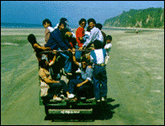
Inani : It is about 32 km. South of Cox's Bazar and just on the beach, with the sea to the west and a background of steep hills to the east. Inani casts a magic spell on those who step into that dreamland. It is only half an hour's drive from Cox's Bazar and an ideal place for Sea-bathing and picnic.
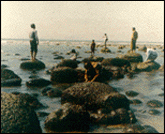
Maheskhali : An island off the coast of Cox's Bazar. It has an area of 268 square kilometers. Through the centre of the island and along the eastern coast line rises a range of low hills, 300 feet high; but the coast to the west and north is a lowlying treat, fringed by mangrove jungle. In the hills on the coast is built the shrine of Adinath, dedicated to siva. By its side on the same hill is Buddhist Pagoda.
Ramu : This is a typical Buddhist village, about 16 km. from Cox's Bazar, on the main road to Chittagong. There are monasteries, khyangs and pagodas containing images of Buddha in gold, bronze and other metals inilaid with precious stones.
One of the most interesting of these temples is on the bank of the Baghkhali river. It houses not only interesting relics and Burmes handicrafts but also a large bronze statue of Buddha measuring thirteen feet high and rests on a six feet high pedestal. The wood carving of this khyang is very delicate and refined.
The village has a charm of its own. Weavers ply there trade in open workshops and craftsmen make handmade cigars in their pagoda like houses.
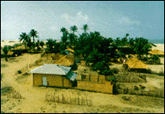
Sonadia Island : It is about seven kilometer of Cox's Bazar and about nine square kilometer in area. The western side of the island is sandy and different kinds of shells are found on the beach. Off the northern part of the island, there are beds of window pane oysters. During winter, fisherman set up temporary camps on the island and dry their catches of sea fish.
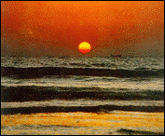
Teknaf : Southernmost tip of Bangladesh, Teknaf situated on the Naaf river and just at the end of the hilly regions of the district. Mayanmar is on the opposite bank of Naaf river. Wild animals and birds are available but the most interesting thing is a journey on the river. Wide sandy beach in the backdrop of high hills with green forests is an enchanting scene never to be forgotten.
Mahasthangarh
Located at a distance of 18 km. to the north of Bogra town. Mahasthangarh is the oldest archaeological site of Bangladesh on the western bank of river Karotoa. The spectacular site is an imposing landmark in the area having a fortified long enclosure. Beyond the fortified area, other ancient ruins fan out within a semi-circle of about 8-km. radius. Several isolated mounds, the local names of which are Govinda Bhita Temple, Khodai Pathar Mound, Mankalir Kunda, Parasuramer Bedi, Jiyat Kunda etc. surround the fortified city.
This 3rd century BC archaeological site is still held to be of great sanctity by the Hindus. Every year (mid-April) and once in every 12 years (December) thousands of Hindu devotees join the bathing ceremony on the bank of river Karatoa. A visit to the Mahasthangarh site museum will open up for one a wide variety of antiquities, ranging from terracotta objects to gold ornaments and coins recovered from the site.
Also noteworthy are the shrine of Shah Sultan Bulki Mahisawary and Gokul Medh in the neighborhood of Mahasthangarh.
Paharpur
In Paharpur, a small village 5 km. west of Jamalganj railway station in the greater Rajshahi district, the remains of the most important and the largest known monastery south of the Himalayas has bee excavated. This 8th century A.D. archaeological find covers approximately an area of 27 acres of land. The entire establishment occupies a quadrangular court, measuring more than 900 ft. and from 12fh to 15ft. in height with elaborate gateway complex on the north. There are 45 cells on the north and 44 in each of other three sides with a total number of 177 rooms. The architecture of the pyramidal cruciform temple is profoundly influenced by those of South-East Asia, especially Myanmar and Java. It had taken its name from a high mound, which looked like pahar or hillock. A site museum built recently houses the representative coactions of objects recovered from the area. The excavated findings have also been preserved at the Veranda Research museum at Rajshahi. The antiquities of the museum include terracotta plaques, images of different gods and goddesses, potteries, coins, inscriptions, ornamental bricks and other minor clay objects . It has been declared as a World Heritage site by UNESCO.




No comments:
Post a Comment